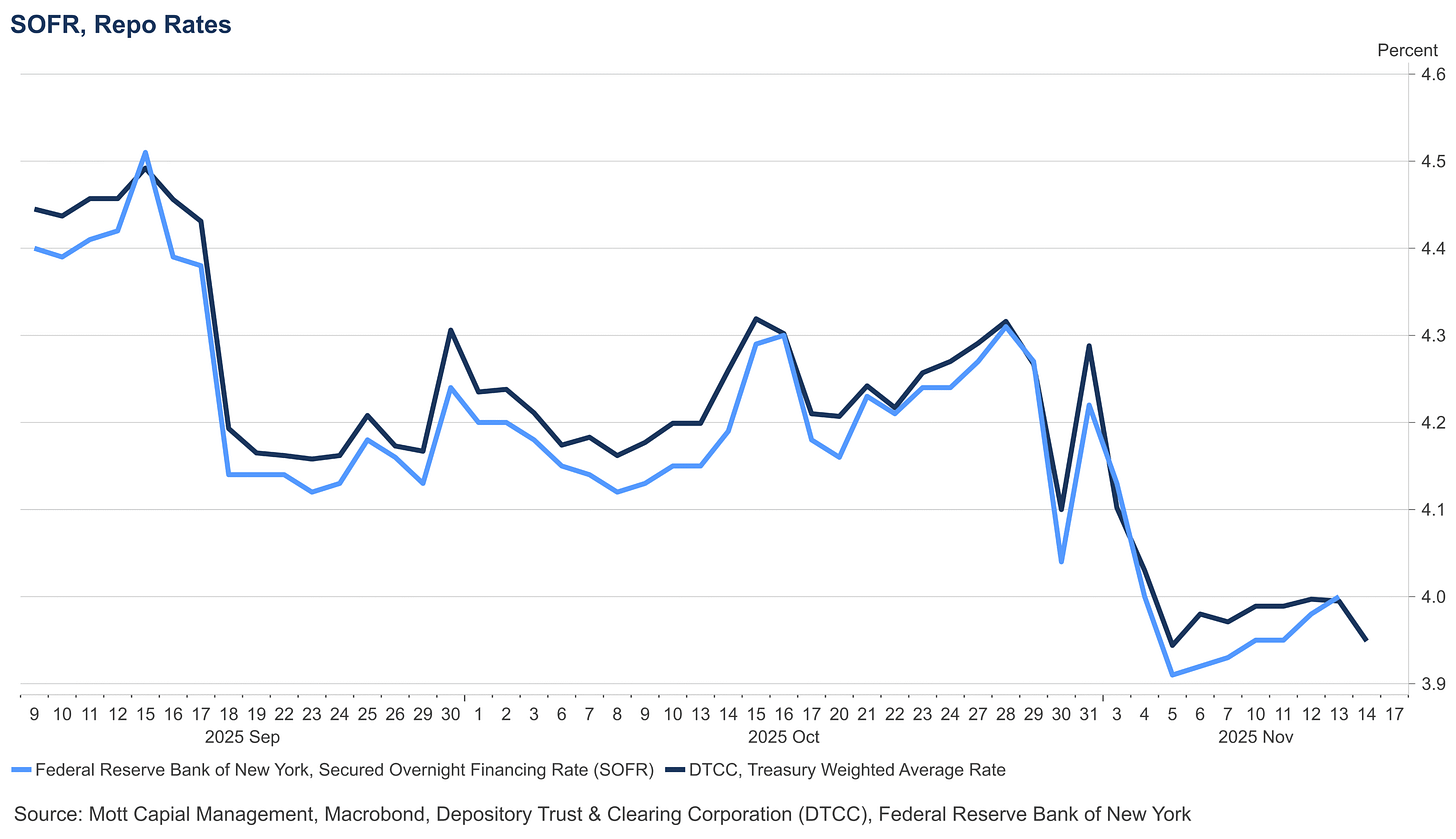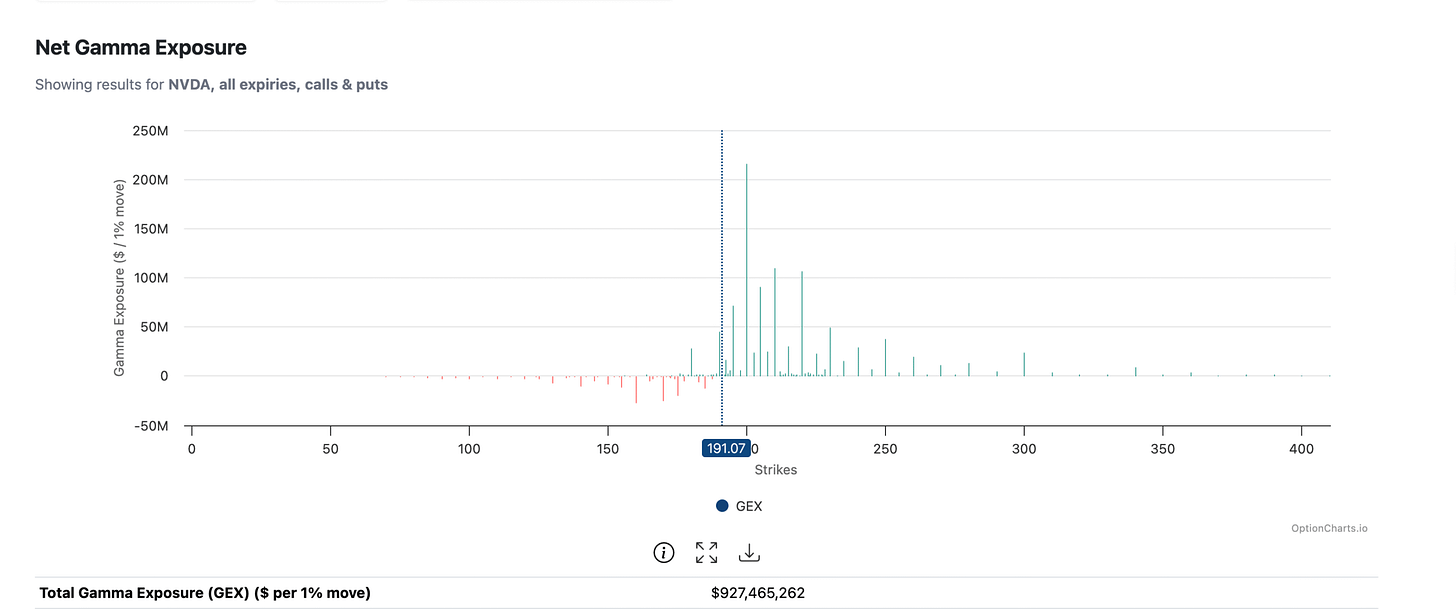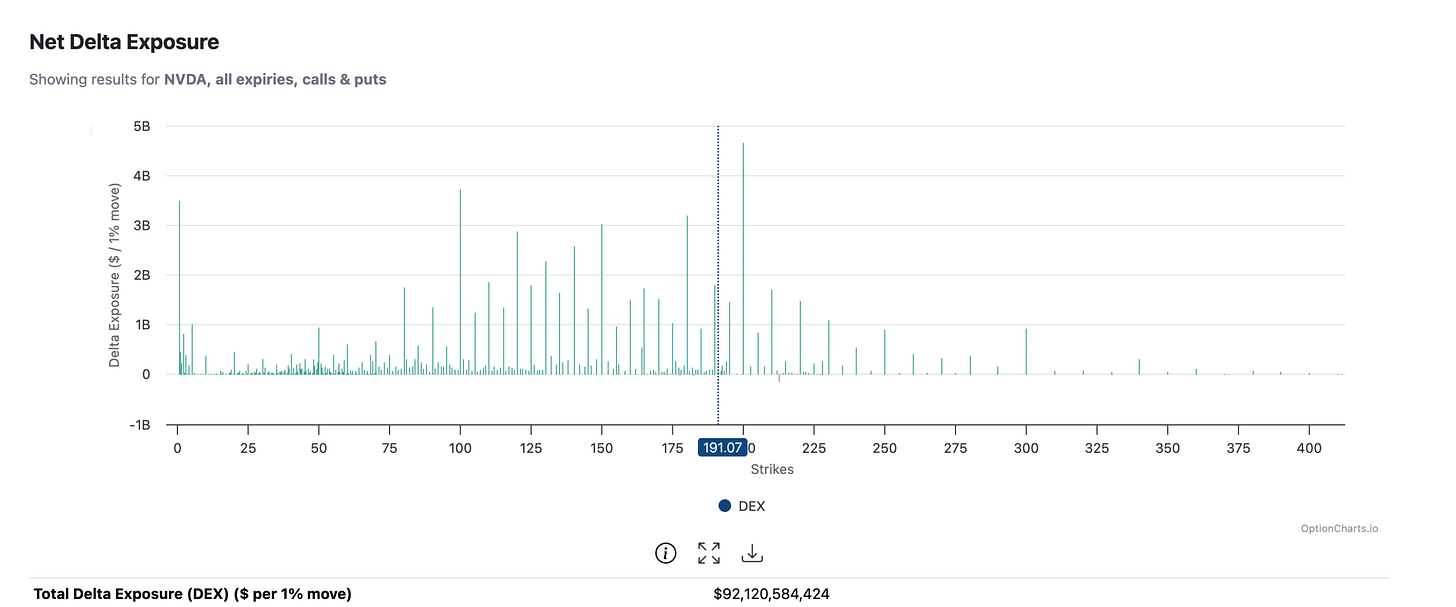Markets Face Tight Liquidity and Event Risk as NVIDIA Reports and Jobs Data Arrive
Now through 3rd December, enjoy 20% OFF Navigating The Market
This coming week will be a busy one with the return of economic data, three Treasury settlement dates, and, of course, NVIDIA’s earnings. All of this will likely mean elevated levels of implied volatility for most of the week, especially Wednesday into Thursday, ahead of NVIDIA’s results on Wednesday afternoon and the U.S. jobs report on Thursday morning. It could set up a somewhat choppy start to the week, probably a bit different from what we’ve seen at the start of the past couple of weeks.
Last Friday was a strange trading session, with implied volatility rising sharply in the pre-market as Bitcoin sold off by about 5%. That pushed the S&P 500 down roughly 1.25% at the open, but implied volatility then declined sharply throughout the morning, lifting the S&P 500. We saw a bit of a choppy close, with the index essentially finishing the day flat after recovering the morning losses, and helping implied volatility reset to much lower levels than where it started.
Friday also saw an easing in overnight funding pressures, as the overnight funding rate actually fell somewhat, which should push SOFR back below 4% on Monday morning. However, there will be a series of Treasury settlements this week, beginning on Monday, totalling $26.7 billion. On Tuesday, another $14 billion is scheduled to settle, and on Thursday, an additional $18 billion is expected.
This means overnight funding rates are likely to rise throughout the day on Monday and remain elevated on Tuesday, with perhaps some easing on Wednesday, only for conditions to tighten again on Thursday and ease once more on Friday. In other words, SOFR is likely to remain around 4% or even higher for most of the week. It also suggests that the use of the Standing Repo Facility will likely remain elevated, as reserve balances have now been drained to very low levels. Liquidity will be tight this week, and we saw firsthand how those dynamics played out on Wednesday and Thursday last week in the stock market.
Implied volatility levels are likely to get bid up on Wednesday heading into NVIDIA’s earnings and ahead of the September jobs report on Thursday morning. You should keep an eye on the VIX 1-Day going into NVIDIA’s results, because it could rise to around 20 or even higher, given that implied volatility is already elevated. That increases the odds of a volatility crush following Thursday’s jobs report, regardless of the data and even if NVIDIA falls in the post-market session.
We know there is currently a high level of dispersion in the market, and we also know the index can diverge from NVIDIA’s performance — especially when implied volatility for the S&P 500 is elevated. That dynamic could even lead to a sizable rally, including in scenarios where NVIDIA trades lower.
The odds that NVIDIA actually falls following its results are quite high. Right now, options positioning is extremely bullish, with the market pricing in about a 7% post-earnings move. There’s a massive amount of call gamma built up at the $200 strike, with even more above that. Market maker positioning is currently positive, meaning the stock is in positive gamma — so market makers will generally be sellers on moves higher and buyers on dips, at least until the stock falls below the zero-gamma level, which appears to be somewhere between $180 and $185. Once that level is broken, market makers would flip to sellers.
Additionally, large delta positioning means there are many call owners, and once implied volatility starts to decline, those calls are likely to lose premium quickly. That could generate significant selling pressure on the stock after earnings, even if NVIDIA beats estimates, as it normally does, by $2 billion to $3 billion.
-Mike
Glossary by ChatGPT
Call Gamma – A measure of how quickly an option’s delta changes relative to movements in the underlying asset.
Delta Positioning – The aggregate exposure created by options that reflects how sensitive portfolios are to changes in the underlying asset’s price.
Dispersion – A condition in which individual stock performance diverges significantly from the broader index.
Implied Volatility – The market’s expectation of future price swings embedded in options pricing.
Overnight Funding Rate – The interest rate at which financial institutions borrow or lend funds on an overnight basis.
Positive Gamma – A market-maker positioning state in which they buy dips and sell rallies to maintain hedges.
SOFR (Secured Overnight Financing Rate) – A benchmark rate reflecting the cost of overnight borrowing collateralized by U.S. Treasury securities.
Standing Repo Facility – A Federal Reserve tool that provides cash to eligible counterparties in exchange for Treasury collateral at a fixed rate.
Treasury Settlements – The scheduled closing and funding of newly issued or auctioned U.S. Treasury securities.
VIX 1-Day – A measure of expected S&P 500 volatility over a one-day horizon based on options pricing.
Zero-Gamma Level – The price level at which market makers shift from positive to negative gamma, altering hedging flows.
Disclosure
This report contains independent commentary to be used for informational and educational purposes only. Michael Kramer is a member and investment adviser representative with Mott Capital Management. Mr. Kramer is not affiliated with this company and does not serve on the board of any related company that issued this stock. All opinions and analyses presented by Michael Kramer in this analysis or market report are solely Michael Kramer’s views. Readers should not treat any opinion, viewpoint, or prediction expressed by Michael Kramer as a specific solicitation or recommendation to buy or sell a particular security or follow a particular strategy. Michael Kramer’s analyses are based upon information and independent research that he considers reliable, but neither Michael Kramer nor Mott Capital Management guarantees its completeness or accuracy, and it should not be relied upon as such. Michael Kramer is not under any obligation to update or correct any information presented in his analyses. Mr. Kramer’s statements, guidance, and opinions are subject to change without notice. Past performance is not indicative of future results. Neither Michael Kramer nor Mott Capital Management guarantees any specific outcome or profit. You should be aware of the real risk of loss in following any strategy or investment commentary presented in this analysis. Strategies or investments discussed may fluctuate in price or value. Investments or strategies mentioned in this analysis may not be suitable for you. This material does not consider your particular investment objectives, financial situation, or needs and is not intended as a recommendation appropriate for you. You must make an independent decision regarding investments or strategies in this analysis. Upon request, the advisor will provide a list of all recommendations made during the past twelve months. Before acting on information in this analysis, you should consider whether it is suitable for your circumstances and strongly consider seeking advice from your own financial or investment adviser to determine the suitability of any investment.








